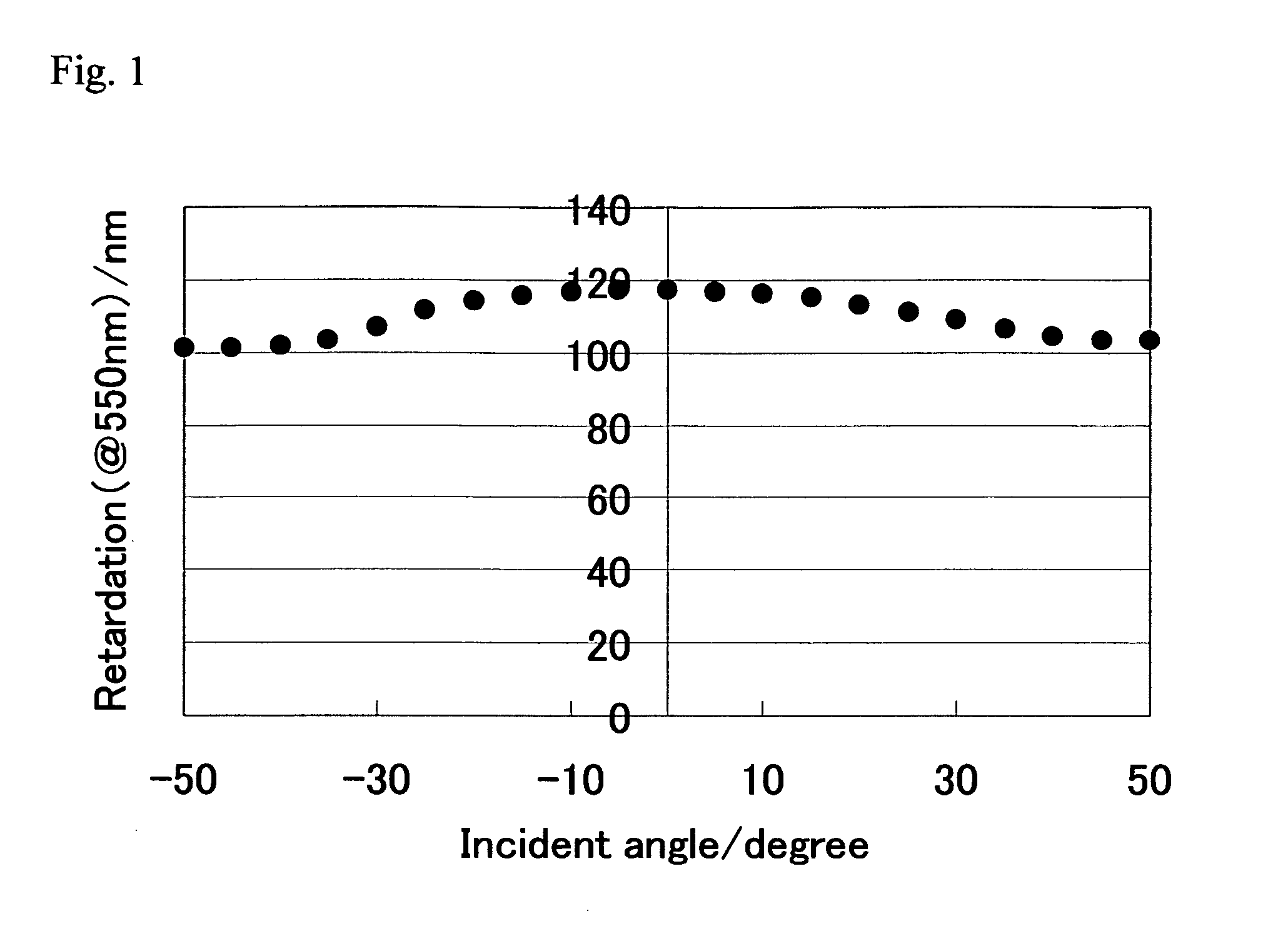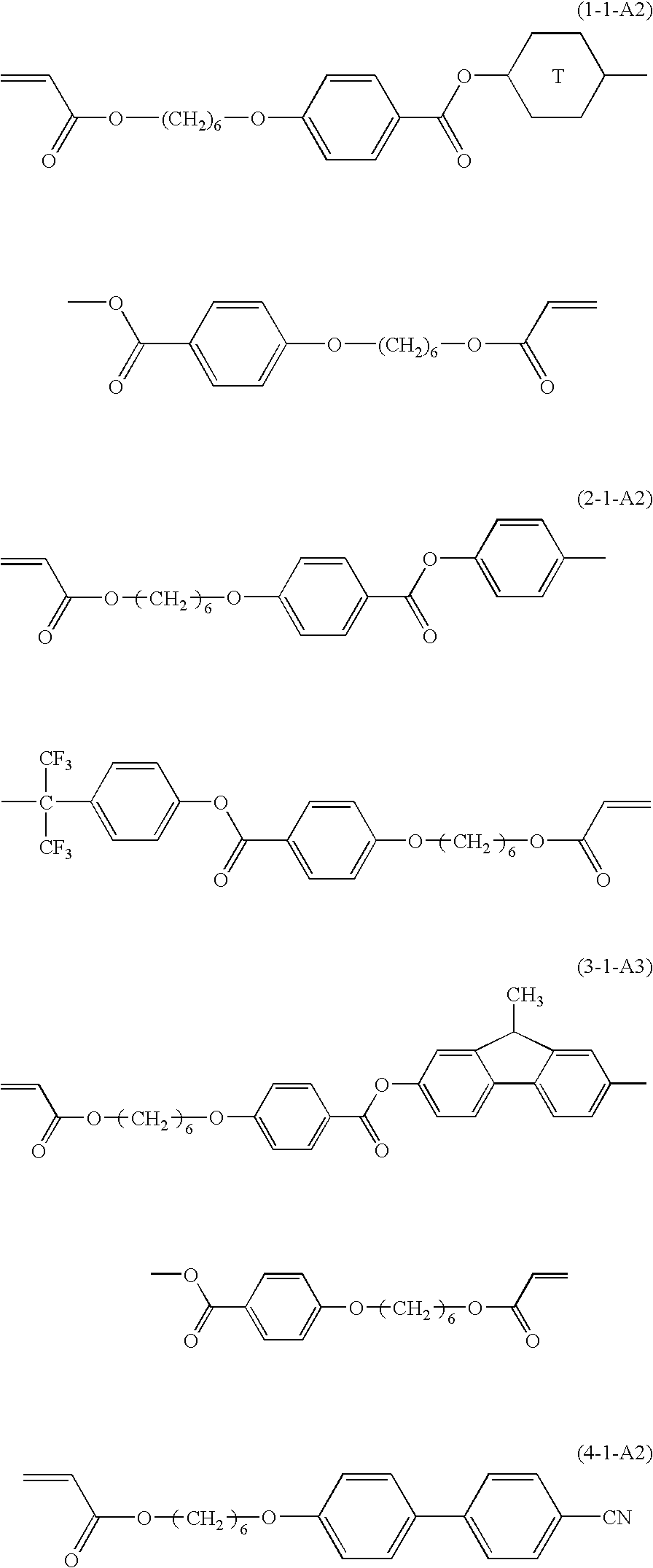Polymerizable liquid crystal composition and homogeneous-aligned liquid crystal film
a technology of liquid crystal composition and polymerizable compound, which is applied in the direction of liquid crystal composition, thin material processing, chemistry apparatus and processes, etc., can solve the problems of difficult to control optical characteristics, difficult to control birefringence, and insufficient function of only one kind of polymerizable compound, so as to prevent the productivity from being deteriorated, enhance the curing property, and increase the regularity
- Summary
- Abstract
- Description
- Claims
- Application Information
AI Technical Summary
Benefits of technology
Problems solved by technology
Method used
Image
Examples
example 1
Preparation of Polymerizable Liquid Crystal Composition (1)
[0181]The compounds (1-1-A2), (2-1-D2), (3-1-A3) and (4-1-A2) were mixed at a ratio (1-1-A2) / (2-1-D2) / (3-1-A3) / (4-1-A2)=40 / 10 / 25 / 25 by weight. The resulting mixture was designated as MIX 1. A fluorine nonionic surfactant (Ftergent FTX-218, available from Neos Co., Ltd.) in a weight ratio of 0.002 and a polymerization initiator (Irgacure 907) in a weight ratio of 0.03 were added to MIX 1. Cyclopentanone was added to the resulting composition to prepare a polymerizable liquid crystal composition (1) having a solvent ratio of 80% by weight.
[0182]Polyamic acid for a low pre-tilt angle (horizontal alignment mode) (Lixon Aligner PIA-5310, available from Chisso Corporation) was coated on a glass substrate (S-1112, available from Matsunami Glass Industries, Ltd.), and after drying at 80° C. for 3 minutes, the coated film was baked at 210° C. for 30 minutes, and then subjected to a rubbing treatment. The polymerizable liquid crystal ...
example 2
Preparation of Polymerizable Liquid Crystal Composition (2)
[0183]A polymerizable liquid crystal composition (2) was prepared in the same manner as in Example 1 except that the compounds (1-1-A2), (2-1-A2), (3-1-A3) and (3-1-A1) were mixed at a ratio (1-1-A2) / (2-1-A2) / (3-1-A3) / (3-1-A1)=35 / 5 / 30 / 30 by weight to prepare MIX 2. A liquid crystal film was produced in the same manner as in Example 1 except that the polymerizable liquid crystal composition (2) was used, and the liquid crystal film had a uniform homogeneous alignment without alignment defect. The measurement of retardation of the film revealed a homogeneous alignment having the same tendency as in FIG. 1. The birefringence Δn of the liquid crystal film was 0.15.
example 3
Preparation of Polymerizable Liquid Crystal Composition (3)
[0184]A polymerizable liquid crystal composition (3) was prepared in the same manner as in Example 1 except that the compounds (1-1-A2), (2-1-D2) and (3-1-A3) were mixed at a ratio (1-1-A2) / (2-1-D2) / (3-1-A3)=40 / 5 / 55 by weight to prepare MIX 3. A liquid crystal film was produced in the same manner as in Example 1 except that the polymerizable liquid crystal composition (3) was used, and the liquid crystal film had a uniform homogeneous alignment without alignment defect. The measurement of retardation of the film revealed a homogeneous alignment having the same tendency as in FIG. 1. The birefringence Δn of the liquid crystal film was 0.14.
PUM
 Login to View More
Login to View More Abstract
Description
Claims
Application Information
 Login to View More
Login to View More - R&D
- Intellectual Property
- Life Sciences
- Materials
- Tech Scout
- Unparalleled Data Quality
- Higher Quality Content
- 60% Fewer Hallucinations
Browse by: Latest US Patents, China's latest patents, Technical Efficacy Thesaurus, Application Domain, Technology Topic, Popular Technical Reports.
© 2025 PatSnap. All rights reserved.Legal|Privacy policy|Modern Slavery Act Transparency Statement|Sitemap|About US| Contact US: help@patsnap.com



